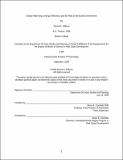| dc.contributor.advisor | Brian A. Ciochetti. | en_US |
| dc.contributor.author | DiBona, Donna K | en_US |
| dc.contributor.other | Massachusetts Institute of Technology. Center for Real Estate. | en_US |
| dc.date.accessioned | 2010-09-22T16:02:57Z | |
| dc.date.available | 2010-09-22T16:02:57Z | |
| dc.date.copyright | 2008 | en_US |
| dc.date.issued | 2008 | en_US |
| dc.identifier.uri | http://hdl.handle.net/1721.1/58655 | |
| dc.description | Thesis (S.M. in Real Estate Development)--Massachusetts Institute of Technology, Dept. of Urban Studies and Planning, Center for Real Estate, 2008. | en_US |
| dc.description | This electronic version was submitted by the student author. The certified thesis is available in the Institute Archives and Special Collections. | en_US |
| dc.description | Includes bibliographical references (leaves 79-81). | en_US |
| dc.description.abstract | This thesis attempts to explore the relationships between the Buildings Sector, energy efficiency and global warming. Through a qualitative analysis the author illustrates the connection between these three areas and shows how both energy efficiency, as a key policy measure, and the Buildings Sector, as the key recipient of such policies, can act together to significantly mitigate the effects of global warming and resulting climate change. First, the reader is given the tools to understand the issues surrounding global warming and climate change. This is accomplished through an overview of related science, history and environmental and economic impacts. Future climate scenarios are explained and mitigation options are offered. Second, an overview of energy efficiency as the primary mitigation option for global warming is given. Terminology, history and mitigation potential of energy efficiency and how it applies across market sectors are reviewed. Barriers to implementation of energy-efficiency projects and the need for strong policy are also explored. Third, the Buildings Sector, showing the most promise for greenhouse gas mitigation through energy-efficiency investments, is analyzed. This analysis focuses on the current consumption patterns of buildings, on available energy-efficient technologies, and on the characteristics of efficiency projects in buildings and how they support the goals of broader climate change policy. The analysis concludes with a review of the barriers to such projects along with an overview of the policies in place meant to overcome these barriers. Finally, the author summarizes her research and offers her conclusions. | en_US |
| dc.description.statementofresponsibility | by Donna K. DiBona. | en_US |
| dc.format.extent | 81 leaves | en_US |
| dc.language.iso | eng | en_US |
| dc.publisher | Massachusetts Institute of Technology | en_US |
| dc.rights | M.I.T. theses are protected by
copyright. They may be viewed from this source for any purpose, but
reproduction or distribution in any format is prohibited without written
permission. See provided URL for inquiries about permission. | en_US |
| dc.rights.uri | http://dspace.mit.edu/handle/1721.1/7582 | en_US |
| dc.subject | Urban Studies and Planning. | en_US |
| dc.subject | Center for Real Estate. | en_US |
| dc.title | Global warming, energy efficiency and the role of the built environment | en_US |
| dc.type | Thesis | en_US |
| dc.description.degree | S.M.in Real Estate Development | en_US |
| dc.contributor.department | Massachusetts Institute of Technology. Center for Real Estate | en_US |
| dc.contributor.department | Massachusetts Institute of Technology. Department of Urban Studies and Planning | |
| dc.identifier.oclc | 316796581 | en_US |
